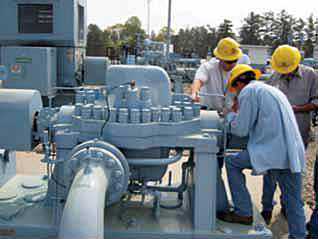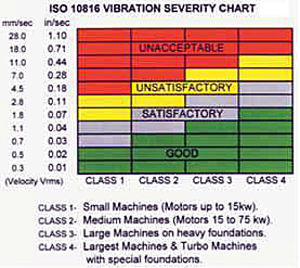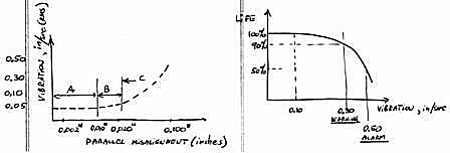Facts can be tough—our emotions may get in the way. What we think we know is not always factual but is based on what we may intuitively feel is an undisputed truth. It is human to expect everyone else to agree with us, regardless if we truly know the facts or just think we do. And if others do not agree, then we think they are incompetent. Many people feel that all pump vibrations are bad, but is this a fact or only what we think is true?
Good Vibrations
I published “Pump-to-Motor Alignment: Why 0.002-in and Not 0.020-in?,” in Pumps & Systems, February 2007, and despite the word “why” in its title, it caused a roar of controversy and a flood of email, most of which expressed surprise, bewilderment and disbelief that the question was raised.

Figure 1. (right) Pump in the field witha fault-detect device installed.
Uri Sela, a retired Exxon engineer, agreed with me that, despite an obvious need to align as best as possible, the question of the factual, data-supported evidence would be helpful. He also agreed that he did not have such factual data. Hienz Bloch, a well-respected ASME Life Fellow and friend, railed strongly against my question and quoted several published works that he claimed would prove that vibrations do have a measured and quantifiable effect on bearing life. However, after I checked the references
(Pruftechnik/Ludeka), none had proof, only a belief that alignment to laser-quality is a “good thing.”
The other references were academic—good information and lecturing but no data. Rob Riley, retired from Air Liquide, wrote a letter citing extensive reliability-centered efforts made by his company, with measured meantime between failure (MTBF) increased from less than four years to more than four years. His study and efforts, albeit excellent overall, had alignment as one of many factors. It still failed to answer whether the alignment, specifically and directly, increased the MTBF. I am still waiting for the answer.
Many readers responded that, to their own surprise, they indeed did not know the true facts on the matter and relied entirely on the intuitive feel that it must be important. Corey Pace, from NewPage paper mill in Kentucky, conducted a laboratory study trying to relate the misalignment to equipment life and, while presenting excellent data showing that misalignment increases vibrations, could not find any quantifiable effect of vibration on the equipment life.
Therefore while we do have factual data that misalignment causes vibrations, the relationship between vibrations and equipment life still remains unanswered, and no quantifiable data is known. Perhaps, one would think, that the doubling of vibration magnitude from 0.3 inches per second to 0.6 inches per second would show a significant decrease in equipment life (failures of bearings, couplings, seals, etc.), but doubling from 0.1 inch per second to 0.2 inch per second might not have the same effect.
Case Study
As an example, we have followed a pump operating with very high vibrations for about two years, taking data every five seconds by a special fault detect device used in the field. This study, “Vibration Analysis Simplified,” was also recently published in Pumps & Systems (November 2010), with vibrations behaving as shown in Figure 2.

Figure 2. Vibration readings from fault-detect device.
Vibrations are shown for vertical direction on the inboard bearing housing of the pump (outboard values and inboard at other directions are somewhat better but also high).
According to the ISO standard, a good vibration level is about 0.07 inch per second (rms velocity)—even for the highest power machines, as shown in Figure 3.

Figure 3. (right) Vibration classifications.
The information in Figure 3, however, is applied to newly installed machines. If applied to existing pumps that have been operating for some time and applied literately, the pumps would have to be shut down. Perhaps most of the operating pumps in the world would need to be shut down. For that reason, a practical field limit of 0.3 inch per second (rms velocity) is used, and although other parameters (speed, power, type of foundation and the pump type) may affect the pump, this limit is generally a good approximate starting point. This 0.30 inch per second is a warning level, and 0.50 inch per second is used as an alarm level.
Reviewing the live trend of the vibrations in Figure 4, note how frequently not only the warning but also the alarm level has been exceeded for this pump, with values reaching as high as 0.90 inch per second. Figure 4 shows several months of data. However, the pump behaved like this for years.
I have two questions for you:
What would you say if I told you the vibrations are 0.90 inch per second for a pump?
What would you then say if I told you it operated like this for many years and meantime between failure (MTBF) is around 10 years, and meantime between repairs (MTBR)—minor repairs—is about six years?

Figure 4. (left) Vibrations and equipment life relationships.
The interesting and factual information to have would be a field tested (proven) relationship between the misalignment and vibrations, and then a relationship between the vibrations and the equipment life. This would be valuable data. While I do not know, but I think, that such a relationship would look like Figure 4. From 0.002-inch (laser work) to 0.010-inch misalignment (Region A), there would be very little (I think) effect on vibrations. Region B (straight edge effort) would have a very slight uptick, and after that (Region C), the raise of vibrations would become noticeable, reaching a warning level (0.30 inch per second) at about a 0.100-inch misalignment.
The equipment life relationship would show a little change until about 0.10 inch per second (overall rms), then a minor reduction until 0.30 inch per second and after that toward the alarm value of 0.50 inch per second, perhaps halved life as shown in Figure 4.
Now, your mission, should you choose to accept it, is to prove, disprove, or enhance the figures in this article with proven (not theory) data—which, I am afraid is not an easy
task! Keep in mind that we are not arguing against low vibrations—we just want to know the facts.
Pumps & Systems, March 2011


